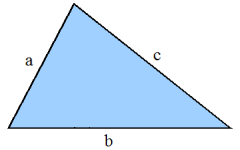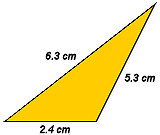We have a little more to discuss about triangles. First, there is an alternative formula for finding the Area of a triangle when all three sides are known (and the height may not be known). Second comes the most infamous of all mathematical formulas since antiquity.
|
ancient times; former ages; times long since past |
|---|

| A = √s(s - a)(s - b)(s - c) |
|---|
| where s =12P (semiperimeter) |
|
frightning or intimidating; discouraging through fear; overwhelming |
|---|
Find the Area of a triangle with the dimensions shown in the illustration.

|
incapable of being determined or discovered; not able to establish, achieve or acquire |
|---|
|
a superior ability acquired through practice and observation; adroitness or dexterity in a particular skill |
|---|
| s = | 1 2 (6.3 cm + 2.4 cm + 5.3 cm) |
| = | 1 2 (14 cm) |
| = | 7 cm |
| A = | √7cm(7cm - 6.3cm)(7cm - 2.4cm)(7cm - 5.3cm) | |
| = | √7cm(0.7cm)(4.6cm)(1.7cm) | |
| = | √38.318cm 4 | |
| = | √38.318 × √cm 4 | |
| ≈ | 6.2 cm² | |